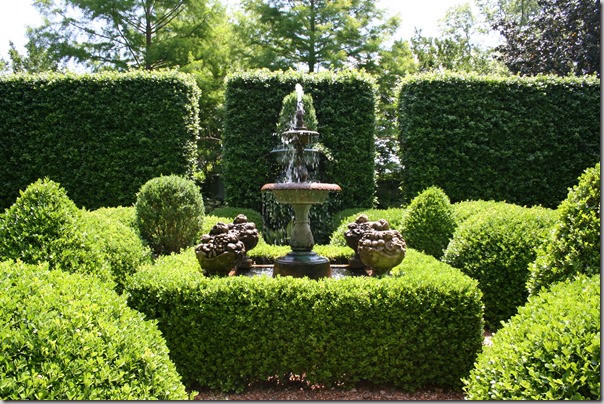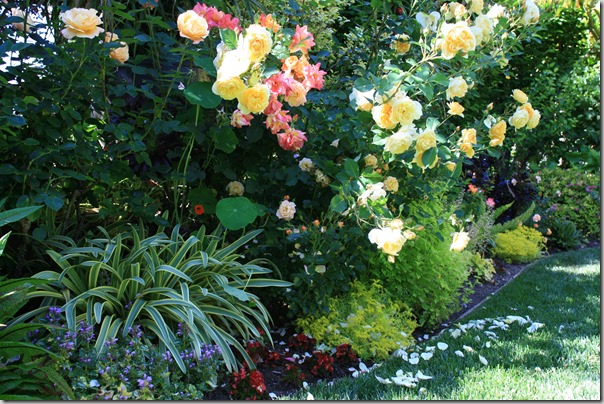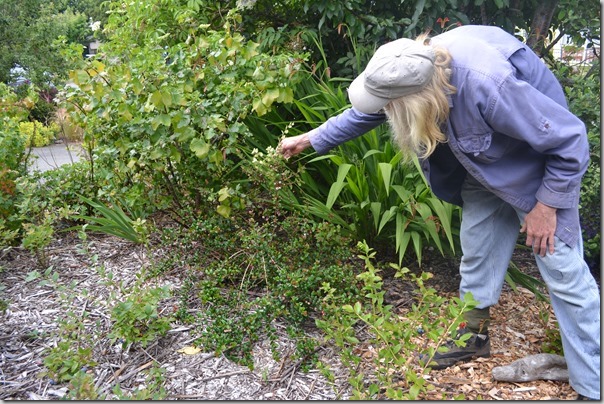
In my landscape design practice, it is rare to find a client who does not ask for a low-maintenance garden. However, the way people define low-maintenance varies so wildly that the term has almost lost its meaning.
While the generally accepted definition of a low maintenance plant would be something that you do not need to maintain more than once per year, you could still put together a planting plan based entirely on plants that fit this definition of low maintenance, and have it be a yard where you have to be outside fussing with something almost constantly. (I’ve written more about that here.)
In addition, even plants which fall under that definition vary in how much time and trouble they take. Large grasses like Miscanthus are commonly thought of as low-maintenance, yet each one needs to be trimmed almost to the ground each winter, which involves tying it up, using electric or handheld hedgers to cut it back, filling a quarter of a pickup truck with the detritus from just one grass, then raking up all the little bits that inevitably scatter into the surrounding mulch. Is that low-maintenance?
If time is how we’re defining the term, I’d prefer planting a perfectly-sized shrub in that spot, since most shrubs would need only 5-15 minutes of gentle shaping once per year and can be ignored for some time once an appropriate form is established.
Yet maybe time isn’t the only factor in how we feel about maintenance, because the definition of low-maintenance seems to differ from person to person. Recently, on a private forum for garden professionals, we had a discussion about low-maintenance landscaping where some of these differences popped up.
Here are some of the definitions of low-maintenance these professionals personally espoused:
Easy to hire out
 Low-maintenance? It only takes five minutes to mail the check!
Low-maintenance? It only takes five minutes to mail the check!
One person talked about her low-maintenance knot garden made of boxwood which, she enthusiastically said, only needed to be maintained twice per year. I heard, “low-maintenance knot garden” and laughed, appreciating her sarcasm and dry wit – except – she was serious!
In my view, there is absolutely nothing low-maintenance about running a hedger around a large section of boxwood twice per year, and then having to clean all the little leafy bits out of the surrounding mulch and gravel. It’s a time-consuming pain in the neck.
However, others jumped in with the valid point that in places like LA where there is a large immigrant population, tasks such as hedging or running a mower can be hired out easily and cheaply, so the amount of time or frequency of care is a lot less important than the type of work that needs to be done. In that setting, a formal garden with hedges and lawn could indeed be considered low-maintenance because it is such an easy and inexpensive thing to hire out.
In this setting, even a simple shrub planting is higher maintenance/ higher cost because you’ll either need to find a more specialized crew to take care of it, or develop the knowledge to do the work personally. So the skill or cost required to maintain something should absolutely be factored into any judgment of whether or not a landscape will be low-maintenance. It’s not just a simple matter of how much time it takes to maintain.
Something you enjoy doing
 A labor of love in Raul Zumba’s garden.
A labor of love in Raul Zumba’s garden.
Another thing to factor in is whether or not you’ll enjoy doing the maintenance, if you plan to maintain it yourself. Is deadheading flowering perennials fun, but weeding – not so much? Is planting and caring for your annual flower bed a pleasure, rather than a fussy chore? Or do you enjoy the stress release of weeding, but hate having to research and worry about whether you are pruning everything properly? The very definition of a “hobby garden” is something that doesn’t feel like work.
If you’re a collector or love one aspect of gardening, then tending your succulent wall or fluffing your container gardens (for example) wouldn’t be something to eliminate. After maximizing fun, avoiding irritations is also important. There are a number of plants that are downright unpleasant to prune, such as Mexican feather grass (which gets itchy seeds stuck in your clothes), Buddleia (which lets loose clouds of hairy dust which can give you a nasty sinus infection if you don’t wear a mask), and things like barberry which have painful thorns. I’d rather do a neutral task like weeding all day than tackle a Buddleia and be stuck with itches and sniffles.
Again, while the usual definition of low maintenance puts time above all other considerations, I’m going out on a limb here and saying that your own personal preferences define work vs play.
Plants with benefits
 A permaculture enthusiast showing off some edibles (photo by Janette Heartwood).
A permaculture enthusiast showing off some edibles (photo by Janette Heartwood).
Recently I designed a landscape for a fellow who wanted as little maintenance as possible, because he knew he just wasn’t going to find time in his busy schedule to maintain ornamental plants. Yet he made it clear that he was more than happy to have as many edible plants as possible tucked into the landscape, and said that even if they needed maintenance multiple times per week during some times of the year, his enthusiasm for eating fresh food out of the garden would lure him outside to spend time in the landscape.
There are also people who so enjoy watching birds and wildlife, that no maintenance is too much if they are attracting hummingbirds and songbirds into the garden. They are more than happy to refill their birdfeeders every day or even twice a day, and take great pains to sterilize their hummingbird feeder with each refill. For them, learning the ins and outs of maintaining a wildlife friendly garden is no big deal. But if they aren’t watching birds in that area of the landscape, then their level of enthusiasm for messing about with it will be close to nil.
This is why many busy, working people who might otherwise want low-maintenance have been interested in the “front yard food” trend, or in getting rid of their lawns and planting wildlife gardens. The benefits of these types of gardening fire them up to where maintaining these spaces is no big deal, even though some types of edible gardening can take a considerable amount of time and expense.
You can see why I have to laugh when I hear the inevitable statement from new clients that they would like a “low maintenance” landscape. They think the discussion is over, but I know that buried in that simple statement are a host of assumptions that need to be untangled in order to be sure I’m truly getting at the heart of what they want.
Is the term “low-maintenance” meaningless?
No, not at all. But I don’t think we should place a value judgement on the term and say that low-maintenance is good and high-maintenance is bad. As you can see from these examples, sometimes there are benefits from gardens that are more time-consuming, and yet these gardens can still fit gracefully into people’s lives, as long as the type of care is matched to the owner.
The next time you’re considering how to make your landscape less time-consuming, think carefully about what you’re really after, because it’s possible there are some unconsidered options that would enrich your lifestyle and fit into your schedule, yet not traditionally be thought of as low-maintenance.
11 responses to “Redefining “Low-Maintenance” Landscapes”
I’ve not thought of “low maintenance” in these ways before — really interesting!
I personally think that “low maintenance” is something that people automatically ask for now. I’m not a professional but have designed gardens for friends and they all ask for this even though — as you point out — it means something different to everybody.
What a wonderful point you make! I hear low maintenance from nearly every client also and then they branch into all the same areas you brought up. And I had to laugh because my husband literally say to them…the lowest maintenance I can offer is you write me a check : ) They laugh and then usually say they will take him up on that. We don’t do lawns but we have trained our crew to do seasonal maintenance. Many clients still like to putter a bit but can call us in when they feel overwhelmed. I like to create gardens that invite you out into them. My preference would be that they would interact with their gardens. I feel if they have a sense of ownership from the beginning of the design process it helps. Growing food has become a wonderful way to draw people out. I also leave little patches where they can plant annuals. Clearly you are a good listener and that is the key to finding what the client really wants. Happy Gardening!
Laurin, I love your philosophy and think you are so right – the best gardens are ones where the client has feelings of love and ownership. Even if they don’t do all the work themselves, if they occasionally putter or sometimes tackle a project here or there, they come to understand the garden and are thus more appreciative of the work our maintenance crews do later. We get called in when people get overwhelmed too, and it happens often – even a low-maintenance garden needs regular, ofte skilled care to do well, and that can be hard to provide if you also work and have a social life!
I can honestly say that EVERY single client who hires me to install something (or friends who ask for advice) says that they want a “low maintenance” garden/yard. I always laugh and tell them that the only truly low maintenance yard is to cement the sucker, and call it good. You are very right – low maintenance means different things to different people. But I still remain surprised at how many people think that installing something like sweet little shrubs means they won’t have to do any work in the yard at all, even after a year. Depends on how you feel about weeds, deadheading, etc. Thanks for the reminder to inquire what “low maintenance” means to the client, rather than what I might assume they’re asking for.
Too funny – “cement the sucker”! 🙂 When faced with that option, most people do concede they are willing to spend some time and effort (or money on a crew) to maintain a space. The idea of an unappealing lava rock or concrete everything out back lends some perspective to the discussion!
I am so with you on the benefits of shrubs for low(er) maintenance gardens. And by that I means ones that are occasionally shaped as they grow but not clipped. I see gardens filled with grasses and perennials being touted as low maintenance as you ‘only have to cut them down once a year’ and wonder if the designer has ever actually done that him/herself. And that’s a clever observation about the things on which people will spend time outside, like bird feeding and edible plants. I hadn’t thought about that before and it would be a wise designer who tried to find them out and then work those client behaviours into their garden design.
Hi Catherine, YES! Grasses and perennials do take time, and it is very vexing as the owner of a maintenance company to have to share the reality of this with clients who were told what a low-maintenance garden they will have by a designer who is maybe not experienced in maintaining these “low-maintenance” plants. The strategies for how these things are planted also make such a difference. I find perennials in large swathes are easier than one here and one there, because we can treat the swathe as one when we cut them back.
Nice article Genevieve. I actually had written a rough draft of a similar post, but you made some excellent points I had not considered. I did not even consider the idea of low cost labor taking care of the maintenance task for you. I’ll just share your post instead!
Anyone that has had to tackle a spring clean up of a yard full of ornamental grasses will definitely agree they are NOT low maintenance. Maybe in summer and fall they are. But not in early spring. When considering if a plant is low maintenance, I like to ask how hard would it to be if I had an entire yard filled with this plant. Would that be low maintenance still? I find that helps to separate the real needy plants from the more “leave it be” ones.
I definitely comes down to getting to know who your client is and what their perceptions of what is yard work and what is yard play.
Jim – that’s a great way of visualizing the true maintenance needs of a plant – multiply it out over the whole yard and see whether you cringe! I’m going to remember that. Sometimes a visceral gut-check like that gives us the most honest answers and cuts through the momentary plant lust which would have us packing a yard full of “once a year” high-maintenance beauties.
It’s interesting that low-maintenance landscaping can have a different meaning among landscapers. The first person mentioned in this post thought of the accessibility of hirable help to maintain her knot garden, while others would think of the amount of work that would actually go into a landscape. I agree, the more you enjoy working on a type of plant, the less labor seems to take to maintain it. There are a few flowers that I love planting, weeding, and watering, so in that case, those flowers would be considered low maintenance to people like me.
I like how you mentioned trying to reduce the parts of gardening you don’t enjoy. I would like to take good care of my landscape and enjoy doing it, but weeding is the one thing that I detest. Perhaps it would be a good idea to consult a landscaper and figure out a way to reduce the amount of weeds so I can enjoy working out in the garden.